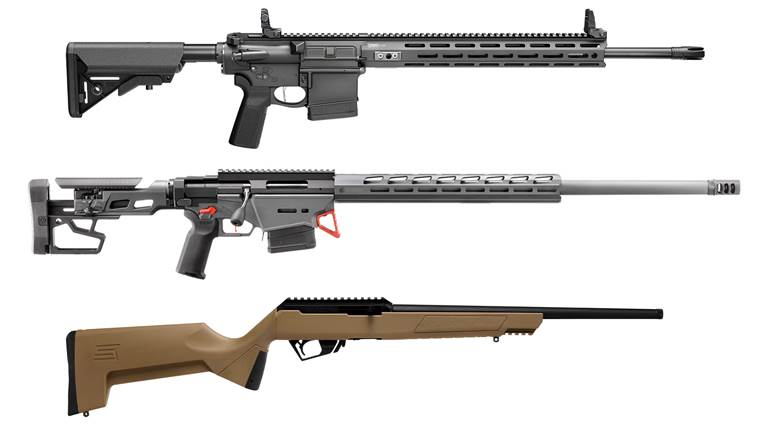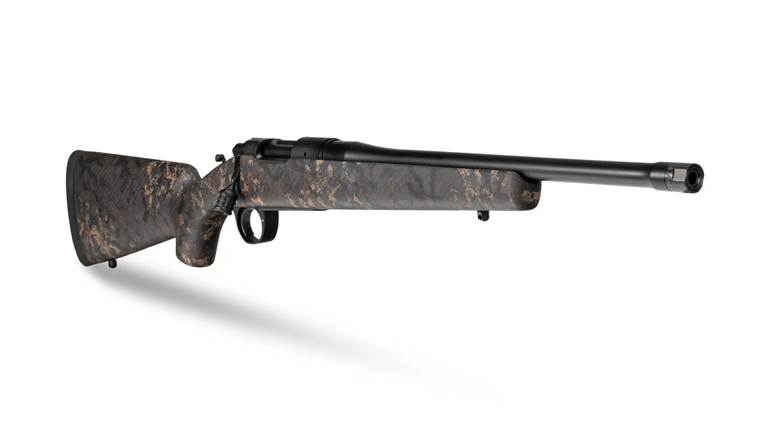
The original World War II-era PPSh-41 was a symbol of Russian resistance to the Nazi invasion. By any standard, it is an iconic historical firearm. It is also a select-fire submachine-gun capable of full-automatic fire, meaning it is a Class III firearm, so examples are subject to legal restrictions on sale, ownership and transport. And they are expensive to purchase and own.
Such legal and financial burdens would make a semi-automatic rimfire replica carbine an attractive alternative as it would be both inexpensive to own and shoot. Now fans of the PPSh-41 are in luck as such a gun, the PPS50/22, is made in Italy by Pietta, and currently imported by Mitchell’s Mausers.
The PPS50/22 is a blowback-operated semi-automatic carbine. Its cylindrical bolt is left in the white. A single claw extractor is located at the 9 o’clock position, and the firing pin is at 12 o’clock on the bolt face. The fixed blade ejector can be found on the left-hand receiver wall. A pair of horizontally opposed guide rods controls the compression of the bolt assembly’s two recoil springs. Fixed to the right-hand side of the bolt is a cylindrical charging handle that reciprocates with the bolt throughout the firing cycle in a slot in the receiver.
The bolt assembly is housed in a one-piece stamped steel receiver with an integral barrel jacket that extends all the way to the muzzle of the PPS50/22’s 16-inch barrel. A series of circular perforations in the barrel jacket, measuring roughly 1/2 inch in diameter, aid heat exhaust. Altogether, the jacket is perforated by six rows of the circular vents. The vents in each row are offset from the vents in the rows adjacent to them. This allows the vents to be placed much closer together. Iron sights are fixed to the top of the receiver with slotted machine screws. They include a buckhorn rear sight V-notch screw-adjustable for elevation, and a fixed front post. Capping the receiver assembly is a slotted plug that threads into the rear of the tube. Three horizontal slotted machine screws anchor the stamped steel trigger assembly to the bottom of the receiver.
The one-piece hardwood stock has a semi-pistol grip at the wrist. A smooth metal plate protects the gently curved buttstock. Generous finger grooves have been cut into the fore-end. Sling attachment is provided by QD sling swivel posts at the bottom tip of the fore-end and the toe of the stock.
The trigger-blocking safety mechanism is controlled by a lever with a curved horizontal paddle. Conveniently located on the right side of the receiver just behind the bolt handle, it is easily manipulated by the thumb of a right-handed firer. Pulling the lever to the rear engages the safety mechanism, and pushing it forward disengages it.
The magazine-release lever is on the bottom of the receiver at the rear of the magazine well. The lever has an extension that passes through the front face of the of stamped steel trigger guard. Pushing forward on the lever allows the magazine to drop free.
A 10-round box magazine comes standard, but 30-round box and 50-round drum magazines are available as accessories. Both box magazines are single-column, with narrow stamped steel bodies and metal followers. Semi-circular spacers that fill out the cavernous magazine recess are attached to the sides of the box magazines. Measuring just more than 5 1/4 inches in diameter, the blued 50-round stamped steel drum replicates the look of the 72-round drum magazine of the PPSh-41. Unlike the drum magazine of the original gun, the PPS50/22’s drum does not have to be disassembled in order to be loaded, the follower spring is relatively stiff, however, and a loading tool is provided.
For best reliability, PPS50/22’s manual recommends using only high-velocity .22 Long Rifle ammunition, which is common for semi-automatic rimfires. Accordingly, we chose a variety of high-velocity .22 Long Rifle from Remington, Winchester and CCI for our evaluation. Although the results shown in the accompanying table are satisfactory, it is fair to say the gun’s heavy trigger pull hindered accuracy. The single-stage unit broke at 6 pounds, 14 ounces with minimal take up and no overtravel. Additionally, iron sights were used exclusively. The top of the receiver has a short tip-off base, but it is mounted so far back on the receiver it is hard to imagine a rimfire scope short enough to be compatible with the gun. However, a reflex sight compatible with a tip-off base might be useful. Both the box and drum magazines proved to be reliable, and there were no malfunctions of any kind during the course of our testing. The large drum proved to be a surprising and welcome aid to offhand shooting. One can grasp the side or the bottom for greater stability.
Overall, the quality of the PPS50/22’s fit and finish is excellent. Those who enjoy high-volume rimfire shooting flavored with a historical military theme will find a lot to love in the PPS50/22 from Mitchell’s Mausers.
Manufacturer: F. lli Pietta, Via Man-dolossa; www.pietta.us
Importer: Mitchell’s Mausers; (800) 274-4124; www.mauser.net
Caliber: .22 Long Rifle
Action Type: blowback-operated semi-automatic, rimfire rifle
Receiver: stamped blued steel
Barrel: 16.1", 4140 blued steel
Rifling: five-groove, 1:16" twist
Magazine: 10-round, single-column detachable box (30-round box and 50-round drum available)
Sights: fixed front post, buckhorn, drift-adjustable for windage rear
Trigger: single-stage; 6-lb., 14-oz. pull
Stock: hardwood: length ofpull, 13½"; drop at heel, 1½"; drop at comb, 2"
Overall Length: 33½"
Weight: 4 lbs., 12 ozs.
Accessories: owner’s manual
Suggested Retail Price: $495 (50-round drum $100)





































